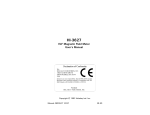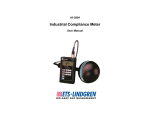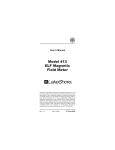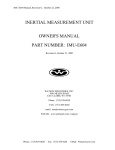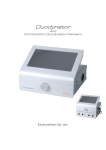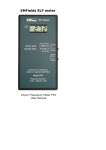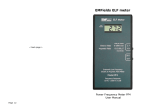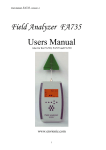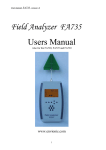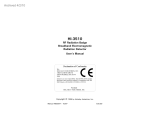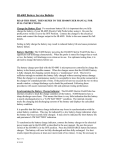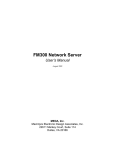Download HI-3604 ELF Survey Meter - ETS
Transcript
HI-3604 ELF Survey Meter User's Manual Copyright Manual #600043B 6/97 © 1992 Holaday Ind. Inc. $12.50 Revision Record Manual # 600043 HI-3604 Survey Meter Revision --A B Description Release New LCD Added CE Label Date 8/92 12/92 6/97 TABLE OF CONTENTS 1.0 DESCRIPTION . . . . . . . . . . . . . . . . . . . . . . . . . 1 2.0 SPECIFICATIONS . . . . . . . . . . . . . . . . . . . . . . . . 4 3.0 OPERATION . . . . . . . . . . . . . . . . . . . Start Up . . . . . . . . . . . . . . . . . . Digital Display . . . . . . . . . . . . . . Electric Field/Magnetic Field Mode Selection . . . . . . . . . . . . . . . . . Keypad Inputs . . . . . . . . . . . . . . Keypad Matrix . . . . . . . . . . . . . . ....... ....... ....... 11 11 13 ....... ....... ....... 13 14 14 4.0 POWER FREQUENCY FIELDS . . . . . . . . . . . . . . . 19 5.0 EXAMPLE APPLICATIONS . . . . . . Field Strength Measurements Waveform Measurements . . Frequency Measurements . . . . . . 23 23 26 30 6.0 MAINTENANCE . . . . . . . . . . . . . . . . . . . . . . . . Battery Replacement . . . . . . . . . . . . . . . . . 31 31 7.0 USING THE HI-3616 FIBER OPTIC REMOTE CONTROL . . . . . . . . . . . . . . . . . . . . . . . . . . . . Turn-on Procedure When Using the HI-3616 . . . . . . . . . . . . . . . . . . . . . . . . . . . . . . . . . . . . . . . . . . . . . . . . . . . . . . . . . . . . . . 33 33 LIMITED WARRANTY HOLADAY INDUSTRIES, INC. WARRANTS EACH MODEL HI-3604 ELF SURVEY METER TO BE FREE FROM DEFECTS IN MATERIAL AND WORKMANSHIP FOR A PERIOD OF ONE YEAR FROM DATE OF SHIPMENT TO THE PURCHASER. THIS WARRANTY EXTENDS TO THE ORIGINAL PURCHASER ONLY AND DOES NOT APPLY TO BATTERIES OR ANY PRODUCT OR PARTS SUBJECT TO MISUSE, NEGLECT, ACCIDENT, UNAUTHORIZED SERVICE OR ABNORMAL CONDITIONS OF OPERATION. IN THE EVENT OF INSTRUMENT FAILURE COVERED BY THIS WARRANTY, HOLADAY INDUSTRIES, INC. WILL, WITHOUT CHARGE, REPAIR AND RECALIBRATE THE INSTRUMENT IF RETURNED TO THEIR FACTORY WITHIN ONE YEAR OF THE ORIGINAL PURCHASE, PROVIDED THAT HOLADAY INDUSTRIES' EXAMINATION DISCLOSES TO ITS SATISFACTION THAT THE PRODUCT WAS DEFECTIVE. HOLADAY INDUSTRIES, INC. MAY, AT ITS OPTION, REPLACE THE PRODUCT IN LIEU OF REPAIR. IF THE DEFECT WAS CAUSED BY MISUSE, NEGLECT, ACCIDENT, UNAUTHORIZED SERVICE OR ABNORMAL CONDITIONS OF OPERATIONS, REPAIRS WILL BE BILLED AT A NOMINAL COST. IN SUCH CASE, AN ESTIMATE WILL BE PROVIDED BEFORE WORK IS STARTED IF REQUESTED BY THE PURCHASER. FOR WARRANTY SERVICE, CONTACT HOLADAY INDUSTRIES, INC. GIVING FULL DETAILS OF THE FAILURE AND THE SERIAL NUMBER OF THE INSTRUMENT. YOU WILL THEN BE GIVEN SERVICE INFORMATION OR SHIPPING INSTRUCTIONS. RETURN THE INSTRUMENT TO THE FACTORY TRANSPORTATION PREPAID. REPAIRS WILL BE MADE AT THE FACTORY AND THE INSTRUMENT RETURNED TO YOU TRANSPORTATION PAID. HOLADAY INDUSTRIES, INC. ASSUMES NO RESPONSIBILITY FOR LOSS OF, OR DAMAGE TO, PRODUCTS IN TRANSIT. WARNING SPECIAL CAUTION IS ADVISED WHEN WORKING IN ENVIRONMENTS WHERE CONTACT WITH HIGH VOLTAGE OR HIGH CURRENT CIRCUITS OR APPARATUS IS POSSIBLE. THIS IS PARTICULARLY TRUE WHEN ATTEMPTING TO OBTAIN ELECTRIC OR MAGNETIC FIELD STRENGTH MEASUREMENTS IN CONFINED QUARTERS, FOR EXAMPLE INSIDE CABINETS CONTAINING ELECTRICALLY OPERATED EQUIPMENT, ELECTRIC POWER SUBSTATIONS OR IN VERY CLOSE PROXIMITY TO THE CONDUCTORS OF ENERGIZED POWER LINES. ACCIDENTAL CONTACT WITH OBJECTS OR CIRCUITS OPERATED AT HIGH VOLTAGES OR HIGH CURRENTS CAN BE LETHAL! HOLADAY INDUSTRIES, INC. ASSUMES NO LIABILITY FOR DAMAGES OR PERSONAL INJURY WHICH MAY RESULT FROM ACCIDENTS ARISING OUT OF USE OF THIS EQUIPMENT. HI-3604 Manual 1.0 Page -- 1 DESCRIPTION The HI-3604 Power Frequency Field Strength Measurement System is designed to assist in the evaluation of electric and magnetic fields that are associated with 50/60-Hz electric power transmission and distribution lines along with electrically operated equipment and appliances. Direct digital readout of field strength is provided by the instrument with the ability to read the meter remotely via a special fiber optic remote control (Model HI-3616) which is available as an option. The HI-3604 finds applications in research and environmental field studies where knowledge of the strength of power frequency fields is required. It is designed to provide engineers, industrial hygienists and health and safety personnel with a sophisticated tool for the accurate investigation of power frequency electrical environments. The HI-3604 has two switch selectable sensors for measuring both electric and magnetic fields (see Figure 1-1). The instruments' capabilities include datalogging, waveform output, full auto-ranging, and a custom Liquid Crystal Display (LCD) with a bar graph, as standard features. All selection and control functions are input from a front panel membrane switch pad. True RMS detection assures accurate measurements of complex waveforms. The waveform output jack allows observation and evaluation of the actual waveform being measured. The datalogger feature captures up to 112 field readings for later review using front panel controls. Microprocessor technology is incorporated in the HI-3604 to provide for automatic range changing (manual range changing may be selected) and automatic zeroing of the instrument. Electric fields are detected by a displacement current sensor which consists of two thinly separated conductive disks which are connected together electrically. When immersed in an electric field, charge is redistributed among the two parallel disks such that the electric field between the two disks remains at zero. This redistribution of charge is reflected as a displacement current which can be measured and subsequently, Page -- 2 HI-3604 Manual related to the external electric field strength. This type of transducer possesses a flat frequency response and permits accurate measurement of fields having significant harmonic content with energy at frequencies above the fundamental of 50 or 60-Hz. Surrounding the circular displacement current sensing disks is a coil consisting of several hundred turns of fine gage wire. When placed in an alternating magnetic field, a current is induced in the coil which is proportional to the strength of the applied magnetic field. Magnetic field strength is then determined by measuring the voltage developed across the terminals of the coil. While an unterminated loop will provide an output which is directly proportional to the frequency of the magnetic field, the HI-3604 employs electronic compensation circuitry which results in a tailored frequency response that is flat in the frequency range of importance to power frequency measurements. This feature permits the HI- 3604 to be used in environments having significant harmonic content and yield accurate measures of the resultant fields. Broadband response is required when measuring fields having significant harmonic distortion such as may occur with electrical machinery. The outputs of both field transducers are measured with a true root-mean-square (RMS) detector. True RMS detection offers accurate evaluation of fields having a variety of waveforms, including non-sinusoidal waveforms. Thus, whether the field being measured is produced by a near pure sine wave source, like an electric power transmission line, or a highly nonsinusoidal source, like a solid state light dimmer, the HI-3604 will yield consistent measures of the RMS field strengths. HI-3604 Manual Page -- 3 Figure 1-1 HI-3604 ELF Field Strength Measurement System Page -- 4 HI-3604 Manual HI-3604 Manual 2.0 Page -- 5 SPECIFICATIONS Sensors: Concentric plate displacement current electric field sensors 6.5 inch (16.5 cm) diameter 400 turn electrically shielded magnetic field sensing coil Switch selectable magnetic fields Sensitivity: Features: between electric and Electric fields, 1 V/m - 199 kV/m Magnetic fields, 0.1 mG - 20 G All function and range selection changes are made by use of the membrane switch keypads on the front panel. Internal electronic range switching allows full auto-ranging on either the Electric or Magnetic field functions. Max-hold feature stores and displays highest reading Amplitude Response: True RMS field strength measurement for accurate measurement of non-sinusoidal waveforms Polarization Response: Displacement sensor and magnetic field sensor are designed for response to one field polarization component at a time Page -- 6 Power: Output: HI-3604 Manual Two (2) nine-volt alkaline batteries (NEDA 1604A, Duracell MN1604, or equal) Liquid crystal display; preamplifier output via phono jack (analog signal from sensor/preamplifier equal to 1 mV/(mA/m); digital fiber optic signal (for remote reading via connection to HI-3616 Fiber Optic Remote Control) Frequency Response: HI-3604 Magnetic Field Response Figure 2-1 HI-3604 Manual Page -- 7 HI-3604 Electric Field Response Figure 2-2 The HI-3604 Power Frequency Field Strength Meter package includes the Readout-Sensor assembly, batteries, a fitted carrying case and a user manual. Instrument accuracy is derived from a field calibration using a one meter diameter pair of Helmholtz coils for establishing an accurately known magnetic field strength, and a pair of parallel one-meter square aluminum plates separated by 30 cm for creating a known electric field strength. In the case of the Helmholtz coils, a precisely controlled and measured sinusoidal current is driven through the coils and, based on the dimensions of the coils, the magnetic field strength in units of milligauss (mG) is calculated. For electric fields, a sinusoidal voltage impressed across the two parallel plate electrodes is directly measured and used to calculate the electric field strength by dividing the applied voltage by the plate spacing to obtain field strength in units of volts per meter (V/m). In each case, both currents and voltages in the calibration set-ups are determined with a true RMS detector. Page -- 8 HI-3604 Manual The HI-3604 can be user programmed to indicate in either units of milligauss/gauss, milliamperes/amperes per meter, or nano/micro teslas. Refer to section 3.0 OPERATION for further details. The HI-3604 indicates magnetic field flux density in units of millgauss (mG) and gauss (G). Most ELF reports and research in the US today use these units. The SI unit of magnetic field flux density is the tesla (T). Environmental ELF magnetic field measurements are generally reported in units of microtesla (:T) or nanotesla (nT). Magnetic field measurements in free space may be converted to different units through the following relations: 1 mG = 1000 :G = 80 mA/m 1 T = 10000 G 1 mT = 1000 :T = 800 A/m Figures 2-1 and 2-2 illustrate typical frequency response plots for electric and magnetic field strength. The HI-3604 is designed to provide a flat response over the range of frequencies corresponding to the 50 or 60-Hz power line frequency and the first several harmonics. The tailored lowfrequency characteristic to the response helps reduce magnetic field response to movement of the sensor in the earth's constant magnetic field. The bandwidth of the true RMS detector is a function of the amplitude of the applied field. The bandwidth of the HI-3604 is also related to the particular measurement range selected. Thus, for a specific measurement, the bandwidth exhibited may be greater or lesser than shown in Figures 2-1 and 2-2. Generally, maximum bandwidth, and thus accuracy, is obtained for any given field strength by selecting the lowest range (and scale) that still permits an on-scale reading. The HI-3604 also provides for monitoring the waveform of the signal coming from the sensor preamplifier circuit in the input HI-3604 Manual Page -- 9 module. This signal is available from the phone jack located at the bottom of the instrument.Connection of an oscilloscope to this jack will allow observation of the preamplifier output. Page -- 10 HI-3604 Manual HI-3604 Manual 3.0 Page -- 11 OPERATION NOTE: The HI-3604 is enclosed in a rugged aluminum extruded case for protection of its internal circuitry. Because of the nature of its intended use, the field sensor extends from the readout module. The structure of the sensor is a multilayered printed circuit board. It is well secured internally to the aluminum case and has a tough polyester covering but is exposed to greater potential for physical damage because of its size and location. Use care in handling the HI-3604 to avoid damaging the sensor by striking it against objects or applying excessive force to the sensor paddle. When not in use, keep the HI-3604 in its protective case where the sensor paddle is properly supported. Start Up Membrane switches are used for controlling the HI-3604's operation. The switch keypads are activated by gently pressing on the center of the pad with a finger tip. Do not use hard or pointed objects to operate the switch keypads. Turn the unit ON, the default measurement condition is Magnetic Fields. The custom LCD readout displays the units of measure in addition to the observed value. A Bargraph display is provided along the top of the LCD window. This display is an analog approximation of the currently displayed digital value as a percentage of the full scale range. The Bargraph input is unfiltered for fast response when searching for peak fields. The digital display response is digitally filtered for increased ease of operation. This smooths the response to rapidly changing fields. In some measurement situations, however, it may be helpful to increase the response of the digital display, ie. reduce the response time. This is done when the instrument is turned on. Refer to KEYPAD MATRIX in this section, and the operation of the E/H keypad for details. Page -- 12 HI-3604 Manual Figure 3-1 HI-3604 ELF Survey Meter HI-3604 Manual Page -- 13 Figure 3-2 The default display response filter is F-2 (refer to KEYPAD MATRIX in this section for more information). The instrument will normally be received from the factory with this setting (F2). The display response setting is stored in the non-volatile memory of the HI-3604 and if the setting is changed, the new setting will be saved and will become the default condition. For this reason, we recommend that you check the display response setting when you first receive the instrument and after battery replacement. The display response setting does not affect the accuracy of the instrument. The battery condition is indicated by a small "battery" symbol in the lower left corner of the LCD. As the battery voltage decreases, the low battery symbol begins to blink. If the battery condition is allowed to drop below that necessary for proper operation, the display will go blank. Digital Display The HI-3604 uses a custom Liquid Crystal Display to provide information on instrument setting as well as the variables being measured. Refer to Figure 3-2 for the display outline. Electric Field/Magnetic Field Mode Selection The HI-3604 measures both electric (E) and magnetic (H) fields. The unit is switched between the E and H field modes using the membrane switch panel keypads. The units being measured are shown on the LCD display. Page -- 14 HI-3604 Manual Keypad Inputs ON/OFF - Pressing the ON/OFF keypad turns the instrument on; pressing the ON/OFF keypad again turns the meter off. As there is no automatic turn off on the HI-3604, turn the instrument off when not in use or between readings. No warm up is required before using the instrument. ZERO - No zero function is required or provided on the HI3604. The instrument will immediately show the measured field strength. Keypad Matrix For maximum flexibility in operation, the HI-3604 has a keyboard matrix for the upper three keypads on the membrane switch panel. The function of each of the three keys can be changed depending on the location of the CURSOR block in the LCD display. The cursor block is a dark rectangle located at the bottom edge of the LCD display. On turn on, the cursor is located above the leftmost of the three columns of functions on the control panel. In this mode the functions of the three topmost keys are as follows: A. SCALE B. MAX C. E/H HI-3604 Manual Page -- 15 MODE SELECT - Pressing the mode keypad moves the cursor to the right; each push of the pad moves the cursor one position. From the third, or rightmost, position, the cursor moves around to the first position. This allows a total of nine (9) different functions to be assigned to the three keypads. The MODE SELECT keypad is also used to change the display response filters as well as the magnetic field units of measure. When the meter is turned on, a self-test procedure is automatically performed. As part of this procedure, all segments of the display are lit for about two seconds. To review or change the filter and unit settings, press and hold the MODE SELECT keypad while all the segments are lit. In this mode two settings can be changed. Pressing the E/H keypad will step through the filter settings. Pressing the MAX keypad will step through the H-field units of measure. Refer to the descriptions of the E/H and MAX keypads for further details. When the settings are adjusted to the desired values, again press the MODE SELECT keypad to leave the setup mode and begin normal measurement operation. The operational description of the various functions is as follows: SCALE - The SCALE keypad changes the fixed ranges or scales of the instrument. When turned on, the HI-3604 is in the AUTO RANGE mode. The unit determines the correct range within the current mode (E or H field) according to the detected field level. As the field being measured increases or decreases, the range is automatically selected for best resolution and accuracy. In some situations, it may be helpful to fix the scale of the instrument. Pressing the SCALE keypad once fixes the instrument on the current scale setting. Each successive operation of the keypad moves the scale to the next least sensitive range. When the least sensitive scale has been selected, the next operation of the keypad will shift to the most sensitive range again. Page -- 16 HI-3604 Manual To return to the AUTO RANGE mode, press and hold the SCALE keypad until the AUTO indication is shown in the upper left area of the LCD. MAX - While using the instrument for field measurements, the processor is continually saving the highest indicated reading. To recall and display the highest reading, press the MAX keypad. This maximum reading is indicated as long as the MAX keypad is activated. The maximum reading is indicated by the MAX indication near the right edge of the LCD. On releasing the MAX keypad, the reading is held for about two seconds and then the memory is cleared and a new maximum reading accumulated. When the instrument is shifted between the electric and the magnetic field mode, the MAX reading memory is cleared. The MAX keypad is also used to adjust the H-field units of measure. This is done just after the meter is turned on. During the self-test routine, the display will show all segments lit. When all the segments are lit, press and hold the MODE SELECT keypad to enter the display setup mode. Hold the MODE SELECT keypad until the display reads "F-#" and the current Hfield unit of measure. Press the MAX keypad to scroll through the available units. Once the desired units are selected, press the MODE SELECT keypad to save the current setup, leave the setup mode, and begin normal measurement operation. E/H - Pressing the E/H keypad toggles the operation mode between Electric and Magnetic field indications. The current measurement units are displayed to the right of the reading on the LCD. The E/H keypad is also used to adjust the display response time. This is done just after the meter is turned on. During the selftest routine, the display will show all segments lit. When all the segments are lit, press and hold the MODE SELECT keypad to enter the setup mode. Hold the MODE SELECT keypad until the display reads "F-#" and the current H-field unit of measure. Press the E/H keypad to scroll through the four display filter settings. F-4 has the "fastest" response time, ie. the least HI-3604 Manual Page -- 17 filtering. F-1 has the "slowest" response time, ie. the most filtering. The difference in response from level to level is a factor of 2. Experiment with the settings to find which response level is best suited to your measurement requirements. Once the desired units are selected, press the MODE SELECT keypad to save the current setup, leave the setup mode, and begin normal measurement operation. The instrument will normally be received from the factory with the display response filter set at F-2. The display response setting is stored in the non-volatile memory of the HI-3604 and if the setting is changed, the new setting will be saved and will become the default condition. We recommend that you check the display response setting when you first receive the instrument and after battery replacement. The display response setting does not affect the accuracy of the instrument. BATT - The BATT keypad displays the supply battery voltage along with the battery symbol. The low battery indication will begin to flash at about 7.5 volts. When the battery voltage drops to 7.25 volts, the display will blank with only the BATT symbol displayed and the batteries must be replaced. DISP 3/4 - Pressing the DISP pad will shift the display from 4 to 3 digits and back again. In some situations where the measured field is fluctuating, the three digit display will make reading the instrument easier. CLEAR DATA - Clears values stored in the data logging memory. Pressing this keypad will clear all data stored in the data logging memory. When the keypad is pressed a flashing clr is indicated. Holding the keypad until 000 is shown will clear the memory. LOG - Pressing the LOG pad will store the current reading in the data logging memory. When the LOG pad is pressed, the identification number of the value (1-112) is displayed for about Page -- 18 HI-3604 Manual one second followed by the stored value. Immediately upon releasing the key, a new value may be logged by again pressing the LOG pad. Up to 112 values can be stored in this memory. When the memory is filled, successive operations of the LOG key will store the most current reading in memory location 112. PREV - Pressing the PREV key displays the last stored data value. When the key is pressed, the identification number of the value is first displayed for about one second followed by the stored value. The stored value is displayed as long as the key is depressed. About two seconds after releasing the key, the display returns to the current reading. Successive operations of the key will move the displayed value down towards the beginning of the memory (value identification #1). If the PREV key is operated while viewing value #1, the identification value will "wrap around" to the highest stored identification number. NEXT - Pressing the NEXT key displays the next value in the data logging memory. If the NEXT key is operated while viewing the last stored value, the identification number will "wrap around" to value number one. When the displayed value is below 5% of the current full scale, the arrow at the left end of the BarGraph display will indicate. When the "Below Range" arrow is indicating, the accuracy of the reading may not be within the specified tolerance. When possible, the scale should be changed to permit a normal field strength reading without the "Below Range" indication. If the displayed value is too high the " Over Range", the arrow at the right end of the BarGraph, will indicate. Select the next appropriate scale. HI-3604 Manual 4.0 Page -- 19 POWER FREQUENCY FIELDS The HI-3604 finds application in numerous circumstances involving 60-Hz fields. A prime example of the HI-3604's utility is evaluation of electric and magnetic fields in the vicinity of electric power lines. In this case, the electromagnetic field environment surrounding a typical power transmission line can be visualized through Figure 4-1. This figure illustrates a singlecircuit, three phase power line consisting of three separate electrical conductors, each having an impressed voltage which is 120 degrees out of phase with its neighboring conductors. A shield wire may be present above the three phases of the line; this wire, which is grounded, acts as a preferred point for lightning strikes which could, if unprotected, strike the current carrying conductors, potentially damaging and removing the line from service for repairs. A double circuit line would consist of two sets of the three phase conductors. Figure 4-1 Page -- 20 HI-3604 Manual Electric and magnetic fields produced by the power line originate because of the voltages impressed on the conductors and the magnitude of current (electricity) flowing through the conductors. Figure 6 depicts the approximate spatial orientation of these fields; electric field lines are shown to be directed such that they terminate at perpendicular angles to the earth's surface and magnetic field lines are shown as lines encircling the conductors. At any particular point in space, the field can be determined by the superposition of the fields associated with each conductor; because the voltage and current of each conductor is out of phase with that in any of the others, and the conductors have some finite spacing between them, the resulting electric and magnetic fields are calculated on the basis of the vector sum of fields caused by each of the three conductors. At some points the fields can constructively add together causing a relatively elevated field strength. At other points the fields from the conductors may destructively add leading to minima in the fields. Thus, power line fields can have rather complex spatial distributions about the line. Figure 4-2 illustrates this field distribution for a typical 345 kV transmission line carrying 1000 A. In this figure the field strengths have been computed for a height of one meter above the ground from one side of the line to the other. In addition to the normal variation in field strength which is observed along a line transverse to the power line, electric fields beneath power lines are perturbed by the local surroundings. Figure 4-1 illustrates the phenomenon of electric field concentration which occurs above the head of a person standing under the line. Because electric field lines have a tendency to terminate on grounded objects, and because the human body is conductive and is electrically near ground potential, there tends to be a concentration of field lines at the top of the head. This same phenomenon occurs with virtually any grounded object immersed in the electric field environment of a power line and can be confirmed via field measurements. A similar perturbation of the magnetic field does not occur because the body is nonmagnetic. Figure 4-1 also suggests that the electric field lines which terminate on the earth are essentially purely vertically HI-3604 Manual Page -- 21 oriented directly beneath the conductors but at extended lateral distances from the line, there can be some horizontal component to the field. Thus, in measurements of electric fields near power lines, it may be important to explore different polarization components of the field to assess the resultant electric fields at points above the earth. Figure 4-2 indicates that the maximum electric field strength beneath the 345 kV line is expected to be about 3.4 kV/m. The maximum magnetic field strength will be dependent on the magnitude of current flowing in the line; Figure 4-2 represents the magnetic fields if the line was carrying a current of 1000 A and indicates a maximum value of 175 mG (equivalent to 14 A/m). Figure 4-2 Page -- 22 HI-3604 Manual HI-3604 Manual 5.0 Page -- 23 EXAMPLE APPLICATIONS Caution - Use care when using this instrument near energized conductors. Be sure to read the hazard warning located on the Warranty page. Field Strength Measurements Measurement of electric field strength, under a power line or near any other source of electric fields, may be accomplished by supporting the HI-3604 on a non-conductive tripod (Part Number 491009), such as that shown in figure 5-1. Be sure to orient the top surface of the sensor paddle towards the field source. It is critical that the user not hold the instrument since this will significantly alter the response of the HI-3604 providing an apparently enlarged field collecting surface for the displacement current sensor, resulting in an erroneously high indicated field strength. In addition, the presence of the operator's body will tend to perturb the electric field that is being measured. The operator should remain approximately one to two times their height away from the HI-3604 and observe the readings via the use of the HI-3616 Fiber Optic Remote Control. The instrument is supported with the digital readout facing upward; in this position, the electric field lines which are directed downward toward the earth will strike the correct side of the displacement current sensor resulting in an accurate measurement of the field strength. Because of the physical asymmetry in the displacement current sensor it is imperative that the front side of the sensor be directed toward the electric field source. Page -- 24 HI-3604 Manual Figure 5-1 Figure 4-1 shows how the electric field can be perturbed by the body; localized enhancement of the electric field will lead to a decreased field strength in other nearby areas. This inherent shielding effect of the body, unless the body is sufficiently distant from the instrumentation, can lead to inaccurate measures of the electric field strength. Depending on the proximity of the body and its orientation, the perturbation effect of the body can lead to either enhanced electric field strength readings or reduced readings when compared to the true unperturbed field strength. While in some cases it may be desirable to determine the enhanced fields near objects, in general, most field measurements should be directed toward assessing the unperturbed values. Unperturbed field strengths, for example, or so called free space values, are more easily related to internal induced currents in the body. Induced currents represent one potential dosimetric measure of electric field exposure. Measurement of the electric field strength beneath power lines may also be accomplished by laying the HI-3604 on its back HI-3604 Manual Page -- 25 directly on the ground, with the sensor disk facing upward. In this orientation, the vertically polarized electric field component is measured. When performing measurements with the instrument on the ground, care must be exercised to insure that vegetation, such as tall weeds, does not interfere with the field strength measurement due to the shielding phenomenon discussed above. In either case, with the instrument elevated on a tripod or laying on the ground, the HI-3604 should be oriented so that the long axis of the body of the instrument is parallel to the conductors of the power line. This orientation is necessary to reduce any instrument response to any horizontal component of the electric field caused by the asymmetric physical shape of the HI-3604. Figure 5-2 illustrates the correct orientation of the instrument relative to the power line conductors. Orientation of HI-3604 for Measurement of Vertical Electric Field Strength Beneath a Power Line Figure 5-2 Illustration of correct and incorrect orientation of the HI3604 for measurements of electric field strength beneath an overhead power line. Magnetic field strength is measured by typically orienting the sensor paddle perpendicular to the field lines. (The orientation arrows at the top of the sensor paddle surface are intended to Page -- 26 HI-3604 Manual help align the sensor). In this orientation, the sensor loop is aligned so that the maximum number of magnetic field flux lines pass through the loop aperture. While performing magnetic field measurements, the HI-3604 may be held by the operator. The non-magnetic nature of the human body does not perturb the magnetic field nor interfere with the operation of the sensor. Waveform Measurements A useful feature of the HI-3604 is the ability to display waveform information about electric or magnetic fields being sensed. The waveform display output is a 1/8 inch phone jack located on the bottom of the instrument case. Using this output, the waveforms of the incident fields maybe monitored by connection to an oscilloscope. Figure 5-3 is an oscilloscope photograph of the magnetic field associated with a common incandescent light bulb. The field waveform is seen to be essentially a pure 60-Hz sinusoid. Figure 5-4 is a picture of the waveform of the same light bulb magnetic field except that a light dimmer has been introduced to the power supply to the light bulb. In this case, the dimmer has been adjusted to approximately half brilliance and the chopping action of the dimmer is clearly shown. Through a chopping of the waveform, less power is delivered to the bulb resulting in a lower light level. Figure 5-5 represents the waveform of the current supplied by the light dimmer. Figure 5-6 illustrates yet another application of the HI- 3604 in the measurement of the magnetic field waveform caused by the vertical deflection circuits in a typical video display terminal (VDT). The images displayed on the screen of a VDT consist of many horizontal sweeps of an electron beam across the screen to trace out the intended image; when the electron beam reaches the bottom of the screen, it is returned rapidly to the top of the screen from where it again repeats its scan across and down the screen. This vertical refresh, as it is called, gives rise to a triangular shaped waveform which is related to the time during which the beam is being scanned vertically. The HI-3604 Manual Page -- 27 longer part of the waveform trace in Figure 5-6 is related to the time it takes for the beam to travel from the top of the screen to the bottom; the very short transition in the waveform is the time it takes for the beam to return to the top of the screen after reaching the bottom. The peak-to-peak output (in millivolts) from the waveform jack is nominally related to the observed field as follows: Electric Field: Range (full scale) 19.99 199.9 1.999 19.99 199.9 volts volts kilovolts kilovolts kilovolts Magnetic Field: milligauss Range Gauss Range Max. Output (nominal) 20 200 2 200 2 millivolts millivolts volts millivolts volts 10 mV/milligauss 100 mV/Gauss Refer to Section 7, Using the Fiber Optic Remote Control for information regarding the "recorder" output. Page -- 28 HI-3604 Manual Figure 5-3 Waveform of magnetic field (sine wave) produced by an incandescent light bulb obtained by use of an oscilloscope connected to the analog output jack on the HI-3604. Figure 5-4 Waveform of magnetic field produced by an incandescent light bulb operated by a light dimmer at half brilliance obtained by use of an oscilloscope connected to the analog output jack on the HI-3604. HI-3604 Manual Page -- 29 Figure 5-5 Waveform of current supplied by a light dimmer. Figure 5-6 Waveform of magnetic field produced by the vertical deflection circuit in a VDT obtained by monitoring the output from the analog output jack with an oscilloscope. Page -- 30 HI-3604 Manual Frequency Measurements Connection of a frequency counter to the waveform output jack allows immediate measurement of the frequency of the applied magnetic field. To perform this measurement, a portable digital multimeter (DVM) capable of measuring frequency maybe used with the HI-3604 to, for example, determine the vertical refresh rate on a VDT. To perform this measurement, an analog signal sufficient to drive some frequency counters may require that the HI-3604 be placed in fairly strong field. HI-3604 Manual 6.0 Page -- 31 MAINTENANCE Battery Replacement When the battery symbol lights to indicate low battery voltage, replace both batteries. Batteries are replaced by removing the two Phillips flat-head screws and the nuts and lockwashers (on the two fiber optic connectors) on the bottom end plate of the HI-3604 readout module. The batteries are held in place by the end plate and will slide out easily when the plate is removed. Replace with 9 volt alkaline (NEDA 1604A, Duracell MN1604 or equal) being careful to observe proper polarity of each battery (refer to the label on the bottom of the readout module case for proper orientation of the batteries). When viewing the back side of the HI-3604, the batteries go in with the positive terminal facing to the left. The batteries are inserted with the battery terminals pointed into the case as the batteries are inserted. As with any battery operated device, do not leave exhausted batteries in the instrument and remove batteries if the instrument will not be used for an extended period of time. Page -- 32 HI-3604 Manual HI-3604 Manual 7.0 Page -- 33 USING THE HI-3616 FIBER OPTIC REMOTE CONTROL Electric Field measurements with the HI-3604 often require that the instrument user be isolated from the instrument to avoid perturbation of the ambient field. This is especially so in the case of the electric field component. In other situations, the meter may need to be oriented such that it is difficult to observe the Liquid Crystal Display (LCD) on the front of the meter. In these circumstances, the HI-3616 Fiber Optic Remote Control is invaluable for remote reading of the HI-3604 display. Turn-on Procedure When Using the HI-3616 To conserve battery life, the HI-3604 does not normally generate the optical light beam necessary for operation of the HI-3616 Fiber Optic Remote Control. The HI-3604 is normally in a "listening" mode. It is continually looking for a signal or command from the HI-3616. In this manner, it is saving power by not having to use its fiber optic transmitter unless actually communicating with the HI-3616. When turned on, the HI-3616 is programmed to send out short "information request" commands. When such a command is received by the HI-3604, it responds and sends data. The communications between the HI-3604 and the HI-3616 are bidirectional, ie., commands and information travel in both directions. Take care when connecting the fiber optic cable to match the meter and readout connector colors (yellow to yellow; white to white). The HI-3616 is able to control all operations of the HI-3604 from its control panel in addition to displaying the measured field values. Section 6.0 provides instructions on replacement of batteries for both the HI-3604 and the HI-3616. Please note that the low battery symbol indication on the HI-3616 display refers to the battery condition of the HI-3604. The HI-3616 battery life is significantly longer than that of the HI-3604; when the display Page -- 34 HI-3604 Manual of the HI-3616 no longer responds; replace both batteries. The data link between the HI-3604 and the HI-3616 is a plastic fiber cable. While the fiber optic cable is generally very durable, avoid sharp bends in the cable and avoid placing the cable under tension (do not pull on it). Because the data is transferred by light pulses, the ends of the cable must be kept clean and undamaged. Use the plastic caps provided to protect the cable ends when not in use. With the HI-3616 connected and operating, the ELF meter may be located as required for a reading and the value measured observed on the display of the HI-3616. When characterizing exposure the HI-3604 may be positioned at various locations without interference from the instrument user (surveyor). When not in use, the HI-3616 should be turned OFF. Refer to the maintenance instructions in section 6.0 regarding removal of batteries when the instrument will not be used for long periods of time. Using the Recorder Output The HI-3616 includes a 3.5 mm stereo jack, located on the bottom of the unit, used for the recorder output signal. This signal is a DC voltage proportional to the indicated field value. It is a 0-4 VDC signal with the four volt level representing a "full scale" indication. The field value represented by the output signal depends on the setting of the range switch. The output drives a load of 5,000 ohms or more. HI-3604 Manual Page -- 35 -NOTES- Page -- 36 HI-3604 Manual -NOTES-












































